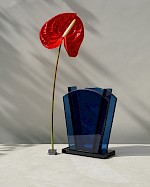Luigi Fontana founded his company back in 1881, his focus was on producing float glass for the construction industry. The company produced refined and exclusive domestic accessories made of glass.
1931 was a major turning point for the company, with the appointment of Gio Ponti as the new art director. In 1932, he decided to get Pietro Chiesa, a renowned and skilled glassmaker, on board. This was the beginning of a new division within the company, which was named Fontana Arte.
In 1934, Chiesa became the second director of Fontana Arte. Fontana Arte’s production became rich and varied. It included furniture, tables, mirrors, sculptures, and stained glass, but it was certainly in the lighting sector where Fontana Arte excelled by creating lamps and lights with the highest standards in glass craftsmanship and modern designs.
It was a period characterised by the recognition of industrial production as one of “the infinite possibilities of artistic expression”, especially in Milan. “Industry is the mode of the 20th century,” declared Ponti. “It is its way of creating. In the art-industry dyad, art is the species, industry the habitat.”
Six years after Chiesa’s 1948 death, Max Ingrand took over as head of design at Fontana Arte. Ingrand brought a similarly expressive formal sensibility to wares such as lamps and mirrors, but he also had a masterful eye for the manipulation of glass surfaces — whether they be cut, frosted, acid-etched or sand-blasted.
The Italian architect Gae Aulenti served as the company’s artistic director from 1979 to 1996, and while she generally insisted that furnishings take second place aesthetically to architecture, she made an exception for Fontana Arte pieces such as the Tavolo con Ruote series of glass coffee and dining tables on wheels.

